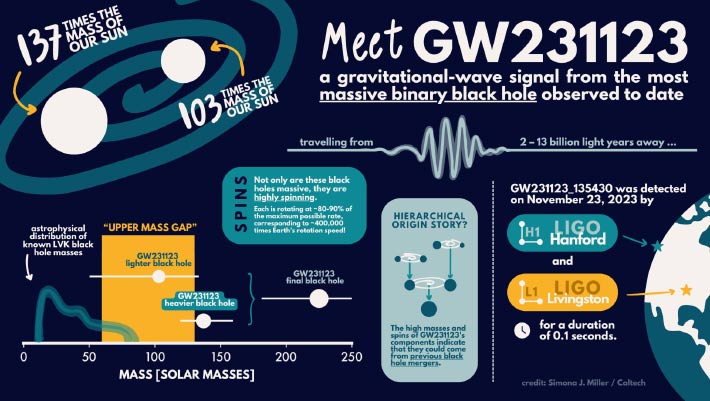Using twin detectors of NSF’s Laser Interferometer Gravitational-wave Observatory (LIGO), astrophysicists with the LIGO-Virgo-KAGRA (LVK) Collaboration have detected the merger of two black holes with the highest combined mass ever observed. Discovered on November 23, 2023 and designated GW231123, the event produced a final black hole more than 225 times the mass of our Sun.
An infographic detailing the GW231123 black hole merger. Image credit: Simona J. Miller / Caltech.
LIGO made history in 2015 when it made the first-ever direct detection of gravitational waves, ripples in space-time.
In that case, the waves emanated from a black hole merger that resulted in a final black hole 62 times the mass of our Sun.
The signal was detected jointly by the twin detectors of LIGO, one located in Livingston, Louisiana, and the other in Hanford, Washington.
Since then, the LIGO team has teamed up with partners at the Virgo detector in Italy and the Kamioka Gravitational Wave Detector (KAGRA) in Japan to form the LVK Collaboration.
These detectors have collectively observed more than 200 black hole mergers in their fourth run, and about 300 in total since the start of the first run in 2015.
Before now, the most massive black hole merger — produced by an event that took place in 2021 called GW190521 — had a total mass of 140 times that of the Sun.
In the GW231123 event, the 225-solar-mass black hole was created by the coalescence of black holes each approximately 100 and 140 times the mass of the Sun.
This puts it in a rare category of black holes called intermediate-mass black holes — heavier than those formed from stellar collapse, but much lighter than the supermassive black holes that lurk in the centers of galaxies.
In addition to their high masses, the merging black holes were also rapidly spinning.
“This is the most massive black hole binary we’ve observed through gravitational waves, and it presents a real challenge to our understanding of black hole formation,” said Dr. Mark Hannam, an astrophysicist at Cardiff University and a member of the LVK Collaboration.
“Black holes this massive are forbidden through standard stellar evolution models.”
“One possibility is that the two black holes in this binary formed through earlier mergers of smaller black holes.”
“This observation once again demonstrates how gravitational waves are uniquely revealing the fundamental and exotic nature of black holes throughout the Universe,” said Dr. Dave Reitze, executive director of LIGO at Caltech.
The researchers present the discovery of GW231123 this week at the 24th International Conference on General Relativity and Gravitation (GR24) and the 16th Edoardo Amaldi Conference on Gravitational Waves held jointly at the GR-Amaldi meeting in Glasgow, Scotland.
_____
LIGO-Virgo-KAGRA Collaboration. GW231123: The Most Massive Black Hole Binary Detected through Gravitational Waves. GR-Amaldi 2025
